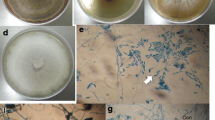Abstract
Fungal endophytes were isolated from the Mediterranean cypress Cupressus sempervirens. Eleven taxa of fungi, all within the Ascomycota, were identified based on PCR amplification and sequencing of the internal transcribed spacer sequences of nuclear ribosomal DNA (ITS rDNA) with taxonomic identity assigned using the NCBI nucleotide megablast search tool. The endophytic fungi included Alternaria multiformis, Didymella sp., Phoma sp., Phoma herbarum, Pyrenochaeta sp. (Dothideomycetes), Penicillium brevicompactum, Talaromyces sp. (Eurotiomycetes), Ascorhizoctonia sp. (Pezizomycetes), Thielavia microspora, and Thielavia spp. (Sordariomycetes). Considering the former findings in US, this indicates that similar ascomycetous classes of fungi, all from Pezizomycotina, associate with the healthy Cupressaceous trees in Iran. The recovered endophytes produced antifungal and antiproliferative metabolites which may contribute to the protection and survival of the host. We speculate that endophyte-infected C. sempervirens may benefit from their fungal associates by their influence on the ecology and biotic stress tolerance of the host plant. Moreover, a novel niche for the identified fungal species is being introduced.
Similar content being viewed by others
References
Abdollahzadeh J, Mohammadi Goltapeh E, Javadi A, Shams-Bakhsh M, Zare R, Phillips AJL, (2009) Barriopsis iraniana and Phaeobotryon cupressi: two new species of the Botryosphaeriaceae from trees in Iran. Persoonia 23:1–8
Aly AH, Debbab A, Kjer J, Proksch P (2010) Fungal endophytes from higher plants: a prolific source of phytochemicals and other bioactive natural products. Fungal Divers 41:1–16
Ershad J (2009) Fungi of Iran, 3rd edn. Iranian Research Institute of Plant Protection Press, Tehran
Hirsch GU, Braun U (1992) Communities of parasitic microfungi. In: Winterhoff W (ed) Handbook of vegetation science, vol 19. Kluwer, Dordrecht, pp 225–250
Hoffman MT, Arnold AE (2008) Geographic locality and host identity shape fungal endophyte communities in Cupressaceous trees. Mycol Res 112:331–334
Hoffman MT, Arnold AE (2010) Diverse bacteria inhabit living hyphae of phylogenetically diverse fungal endophytes. Appl Environ Microbiol 76:4063–4075
Hoffman MT, Gunatilaka M, Wijeratne EMK, Gunatilaka AAL, Arnold AE (2013) Endohyphal bacterium enhances production of indole-3-acetic acid by a foliar fungal endophyte. PLoS ONE 8:e73132. doi:10.1371/journal.pone.0073132
Hosseyni Moghaddam MS (2013) Study on some biological effects of natural products from endophytes of cypress. MSc thesis, Bu-Ali Sina University of Hamedan, Iran
Hosseyni Moghaddam MS, Soltani J (2013) An investigation on the effects of photoperiod, aging and culture media on vegetative growth and sporulation of rice blast pathogen Pyricularia oryzae. Prog Biol Sci 3:135–143
Hosseyni Moghaddam MS, Soltani J (2014) Bioactivity of endophytic Trichoderma fungal species from the plant family Cupressaceae. Ann Microbiol 64:753–761
Hosseyni Moghaddam MS, Soltani J (2014) Psycrophilic endophytic fungi with bioactivity inhabit Cupressaceae plant family. Symbiosis 63:79–86
Hosseyni Moghaddam MS, Soltani J, Babalhavaeji F, Hamzei J, Nazeri S, Mirzaei S (2013) Bioactivities of endophytic Penicillia from Cupressaceae. J Crop Prot 2:421–433
Kobayashi H, Namikoshi M, Yoshimoto T, Yokochi T (1996) A screening method for antimitotic and antifungal substances using conidia of P. oryzae, modification and application to tropical marine fungi. J Antibio 49:873–879
Kour A, Shawl AS, Rehman S, Sultan PH, Qazi PH, Suden P, Khajuria RK, Verma V (2008) Isolation and identification of an endophytic strain of Fusarium oxysporum producing podophyllotoxin from Juniperus recurva. W J Microbiol Biotechnol 24:1115–1121
Kumaran RS, Muthumary J, Hur BK (2008) Production of taxol from Phyllosticta spinarum, an endophytic fungus of Cupressus sp. Eng Life Sci 8:438–446
Kusari S, Lamshoft M, Spiteller M (2009) Aspergillus fumigatus fresenius, an endophytic fungus from Juniperus communis L. Horstmann as a novel source of the anticancer pro-drug deoxypodophyllotoxin. Appl Microbiol 107:1364–5072
Kusari S, Hertweck C, Spiteller M (2012) Chemical ecology of endophytic fungi: origins of secondary metabolites. Chem Biol 19:792–798
Kusari S, Pandey SP, Spiteller M (2013) Untapped mutualistic paradigms linking host plant and endophytic fungal production of similar bioactive secondary metabolites. Phytochemistry 91:81–87
Pakvaz S (2014) Exploring the existence and bioactivity of endohyphal bacteria in endophytic fungi from the cypress Cupressus sempervirens. MSc thesis, Bu-Ali Sina University of Hamedan, Iran
Soltani J, Hosseyni Moghaddam MS (2014) Antiproliferative, antifungal and antibacterial activities of endophytic Alternaria species from Cupressaceae. Curr Microbiol 69:349–356
Soltani J, Hosseyni Moghaddam MS (2014) Diverse and bioactive endophytic Aspergilli inhabit Cupressaceae plant family. Arch Microbiol 196:635–644
Steel RGD, Torrie JH, Dicky DA (1997) Principles and procedures of statistics—a biometrical approach, 3rd edn. McGraw Hill Book International Co, Singapore, pp 204–227
Strobel G, Daisy B, Castillo U, Harper J (2004) Natural products from endophytic microorganisms. J Nat Prod 67:257–268
White TJ, Bruns T, Lee S, Taylor J (1990) Amplification and direct sequencing of fungal ribosomal RNA genes for phylogenetics. In: Innis MA, Gelfand DH, Sninsky JJ, White TJ (eds) PCR Protocols : A guide to Methods and Applications. Academic Press, San Diego, pp 315–322
Zaheri Shoja M (2014) Evaluation of some biological effects of bacterial endophytes from cypress. MSc thesis, Bu-Ali Sina University of Hamedan, Iran
Zhang D, Yang Y, Castelbury LA, Cerniglia CE (1996) A method for large scale isolation of high transformation efficiency genomic DNA. FEMS Microbiol Lett 145:261–265
Acknowledgments
We are thankful to Dr. Soheila Mirzaei (PhD), Freydoun Babalhavaeji, and Dr. Javad Hamzei (PhD) at Bu-Ali Sina University (BASU), Hamedan, Iran for their technical assistances. We also thank Dr. Omid Eini Gandomani (PhD) (Zanjan University, Zanjan, Iran) for his helpful comments on the manuscript. Dr. Jafar Abdollahzadeh (PhD) (Kurdistan University, Sanandaj, Iran) and Dr. Salar Jamali (PhD) (Guilan University, Rasht, Iran) are highly appreciated for their generous gift of the target fungi. This work was financially supported by Bu-Ali BioNanoTechnology Co. (BABiNT), and partially by a grant from BASU to J.S. Jalal Soltani dedicates this work to Mahmoud Khan-Mohammadi and the memories of Baghche-ye Makkarechi.
Author information
Authors and Affiliations
Corresponding author
Additional information
Jalal Soltani and Mahdieh S. Hosseyni Moghaddam have contributed equally to this work.
Rights and permissions
About this article
Cite this article
Soltani, J., Hosseyni Moghaddam, M.S. Fungal Endophyte Diversity and Bioactivity in the Mediterranean Cypress Cupressus sempervirens . Curr Microbiol 70, 580–586 (2015). https://doi.org/10.1007/s00284-014-0753-y
Received:
Accepted:
Published:
Issue Date:
DOI: https://doi.org/10.1007/s00284-014-0753-y




